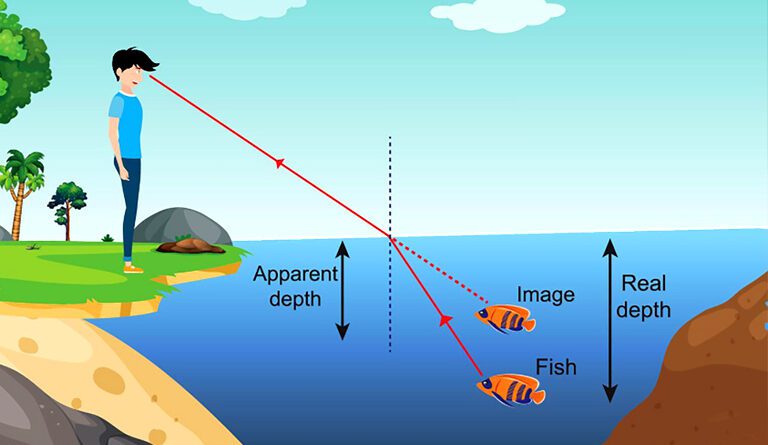Bending Light & Finding Focus: A Hands-On Journey into Reflection and Refraction
Light Reflection and Refraction Experiment For Class 10
Curiosity Questions:
-
How do mirrors help us see ourselves in the right orientation, while lenses help us see faraway things clearly?
-
Why does a straw in a glass of water appear bent or broken?
-
Can light actually “bend” when it passes through glass or water? If so, how can we measure it?
STEM Challenge Introduction:
In this hands-on STEM challenge, we will explore two exciting phenomena reflection and refraction of light. You’ll first determine the focal length of a concave mirror and a convex lens using sunlight or a distant object. Next, you’ll trace the path of a light ray as it passes through a glass slab and observe how it changes direction due to refraction.
This experiment helps connect classroom learning with the real-world design of mirrors in telescopes and lenses in eyeglasses or cameras. Let’s uncover how light behaves and why these optical tools work!
Materials Required:
Mirror and Lens Experiments:
-
Concave mirror (small, approx. 5-10 cm diameter).
-
Convex lens (focal length approx. 10-20 cm).
-
White screen or paper sheet.
-
Stand or clamp for mirror/lens.
-
Measuring scale or ruler.
-
Distant object (building/tree/sunlit window).
-
Marker pen or pencil.
Glass Slab Refraction Experiment:
-
Rectangular glass slab (preferably 10 cm x 5 cm x 1 cm).
-
Drawing sheet (A4 or larger).
-
Pins (4 to 6).
-
Scale, protractor.
-
Sharp pencil.
-
Board or cardboard for pinning.
Eco-friendly/Homemade Alternatives:
-
Use an old magnifying glass as a convex lens.
-
Use a stainless-steel spoon’s inner side as a concave mirror.
Safety Precautions:
-
Do not look directly at the sun while using sunlight as a distant object.
-
Handle glass items carefully to avoid breakage or injury.
-
Use pins carefully and ask for adult help if needed.
-
Conduct the pin experiment on a sturdy surface to avoid slips.
Step-by-Step Process:
Determining the Focal Length of a Concave Mirror / Convex Lens
-
Place the mirror or lens on a stand facing a distant object (e.g., a tree or sunlit building).
-
Behind it, place a white screen/paper to catch the image.
-
Move the screen back and forth until a sharp image forms.
-
Measure the distance between the mirror/lens and the screen using a ruler.
-
Record this as the approximate focal length.
Ray of Light Through a Glass Slab
-
Fix a white sheet on a drawing board.
-
Place a rectangular glass slab at the center and trace its outline.
-
Mark a point (O) on one edge and draw a normal (perpendicular) at that point.
-
Draw an incident ray at an angle (say 30°) to the normal.
-
Place two pins on the incident ray before it reaches the slab.
-
Look through the other side of the slab and align two more pins to make the emergent ray appear in line.
-
Remove the glass slab and join the rays.
-
Measure:
-
Angle of incidence (i)
-
Angle of refraction (r)
-
Angle of emergence (e)
-
Expected Outcome:
-
In Part A, the image will appear sharp at the focal point, helping you measure the focal length.
-
In Part B, you will notice the light bends when entering and exiting the slab, and the emergent ray is displaced but parallel to the incident ray.
Observation:
-
What was the difference between the angle of incidence and the angle of refraction?
-
How did the emergent ray’s direction compare with the incident ray?
-
Was the focal length longer for the mirror or the lens?
STEM Concepts Behind It:
-
Reflection occurs when light bounces off a surface. Concave mirrors converge light to a focal point.
-
Refraction is the bending of light as it moves from one medium to another (e.g., air to glass).
-
Lenses and mirrors are designed using precise optical principles based on these phenomena.
-
Measuring the focal length helps understand how light converges (concave mirror/lens).
 Concept Elaboration:
Concept Elaboration:
This experiment blends concepts from physics (optics), engineering (design of optical instruments), and mathematics (measuring angles, distances). The path of light reveals how we see, how lenses in cameras or telescopes focus light, and how architects use reflection/refraction in designing lighting and spaces.
You also see how geometric constructions are used to trace rays, connect observations with measurements, and validate theoretical predictions.
Real-Life Applications:
-
Concave mirrors are used in torches, shaving mirrors, and solar cookers.
-
Convex lenses are part of microscopes, telescopes, cameras, and spectacles.
-
Refraction through glass is key to fiber optics, vision correction, and even underwater cameras.
-
Glass slab displacement helps understand how light signals bend in communication devices.
Your STEM Challenge:
Try using different lenses (concave lens, cylindrical lens) and predict how the rays behave. Can you find the focal length of a convex lens using a flashlight and screen in a dark room?
Can you reverse the slab experiment and predict where the emergent ray will go before placing pins?
Think Further & Explore More:
-
What happens when you use colored light instead of white light?
-
How would the experiment change with a prism instead of a glass slab?
-
Why do optical illusions often occur due to refraction?
Explore how lenses are made to suit different vision problems and how engineers use ray diagrams to design modern optical tools.
Watch this Animation Video : Light Reflection and Refraction
Also Read this : Electricity Experiment For Class 10


 Concept Elaboration:
Concept Elaboration: